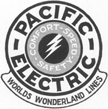
HISTORY: Electric traction in the Orange Empire of Southern California centered about three nuclei: San Bernardino-Redlands, Riverside, and Pomona. Each of these areas enjoyed well-developed electric railway service before the Great Merger of 1911.
The San Bernardino-Redlands group of lines was controlled by the San Bernardino Valley Traction Company, although an independent company operated one line in Redlands(Redlands Central Railway). The Riverside situation was controlled by the Riverside & Arlington Railway, which had been a Huntington enterprise since 1903. An independent company built the line from Riverside to Rialto(Crescent City Railway Company) but R&A under agreement, provided all passenger service over the line.
Pomona was an Old PE operation, as was the San Dimas shuttle, An independent company, the Ontario & San Antonio Heights Railway, owned and operated two lines: Ontario-San Antonio Heights, and Ontario-Pomona.
It is not our intention at this time to delve into the pre-1911 histories of these lines. We will devote our attention mainly to the lines after they became a part of the far-flung PE rail empire. Only a cursory history is outlined to enable readers to appreciate properly the origins of these once-important passenger routes.
The Eastern Division (District) was formed on 30 August 1913 by merging the San Bernardino and the Riverside Divisions, which had been created on 30 September 1911(Pomona was included in the Riverside Division). This was coincidental with the linking up of the Riverside system with the San Bernardino system at Colton-West Highgrove. Superintendent Groftholdt was ably assisted by Assistant Superintendent C.H. Belt---and business was centered at the SP-PE Station, in San Bernardino; additional space was added to the old SP depot to accommodate the new electric railway administrative offices. Without the population density enjoyed by the other Districts, the Eastern District was handicapped in the battle against automobiles and busses. It is not surprising, then, to find that many of the lines of this District were abandoned comparatively early. Without taking into consideration apportioned items of cost such as superintendence, practically all of these lines were operated either at an actual loss to PE or with a very small margin of profit. It is said on good authority that none of the Redlands lines save Smiley Height ever showed a profit! To combat the downward trend, PE installed Birney cars in 1918 in Pomona, Riverside, Redlands and San Bernardino. In 1920 this traditional face of 5 cents went up to 6 cents. This was all in vain, and the excuse of a power shortage in 1924 enabled PE to cut many lines. 1925 saw more go, including all city lines in Pomona. One by one other lines followed, culmination in the final abandonment of Riverside service in 1943.
FACILITIES: Substations in the Eastern District were: No. 22-North Pomona, 23-Etiwanda, 47-Rialto, 27-Riverside, 48-Corona, 24-San Bernardino, 25-Arrowhead, and 26-Redlands. All local lines were 600 volts except the following which were 1200: Ontario-San Antonio Heights, and San Dimas Shuttle, and Pomona-Claremont-Upland east of of North Pomona. Line cars used were 00157 and 00162 after 1916.
Car houses and capacities were: Redlands(4), Riverside(4), Pomona(4), San Bernardino E Street(4), San Bernardino Third Street(4), all as of 1912. The small shops at Riverside and at San Bernardino were capable of overhauling one car each per month. The erection of the new San Bernardino Shops in 1918 focused all maintenance and light repair work there; heavy repairs required the 600-volt cars to be transported to Torrance Shops on flat cars. In the pages to follow, each suburban line of the Eastern Division is given a page, and city lines are consolidated under the name of the city in which they operated.
We acknowledge the valuable aid extended by Messrs. Marler and Stevens of PE who made company records available for our use. Other data came from files of the California Public Utilities Commission, the Electric Railway Journal and Ira Sweet.